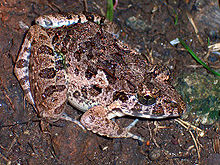Fejervarya
| Fejervarya | |
|---|---|
 |
|
| Crab-eating Frog (Fejervarya cancrivora), one of the "true" Fejervarya | |
| Scientific classification | |
| Kingdom: | Animalia |
| Phylum: | Chordata |
| Class: | Amphibia |
| Order: | Anura |
| Family: | Dicroglossidae |
| Subfamily: | Dicroglossinae |
| Genus: |
Fejervarya Bolkay, 1915 |
| Type species | |
|
Rana limnocharis Gravenhorst, 1829 |
|
| Diversity | |
| 16 species, but see text | |
| Synonyms | |
|
Minervarya Dubois, Ohler & Biju, 2001 |
|
Minervarya Dubois, Ohler & Biju, 2001
Fejervarya is one of the Asian genera of frogs in the Dicroglossidae family. First proposed in 1915 by István József Bolkay, a Hungarian naturalist, the genus did not see widespread adoption at first. As late as the 1990s it was generally included in Rana, but more recent studies have confirmed its distinctness.
These frogs are remarkable for being extremely euryhaline by amphibian standards. Species such as the crab-eating frog (F. cancrivora) can thrive in brackish water, and its tadpoles can even survive in pure seawater.
Fejervarya was first introduced as subgenus of Rana and later placed as subgenus as Limnonectes. It was treated as an independent genus first in 1998. However, Fejervarya sensu lato was found to be paraphyletic with respect to Sphaerotheca. This issue was eventually resolved in 2011 by splitting off Zakerana from Fejervarya. Fejervarya, as now defined, is distributed from eastern India (Orissa) eastwards through Myanmar to southern China and Indochina to the islands of the Sunda Shelf as well as Japan. In contrast, Zakerana contains species from southern Asia (Sri Lanka and Indian subcontinent including Pakistan, Nepal, and Bangladesh)
...
Wikipedia
